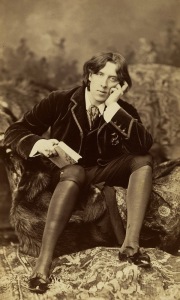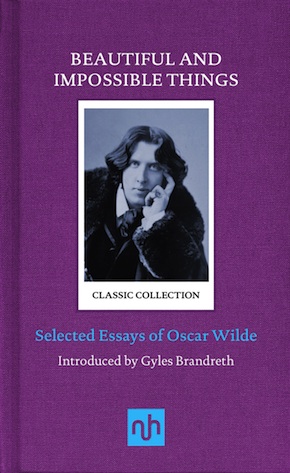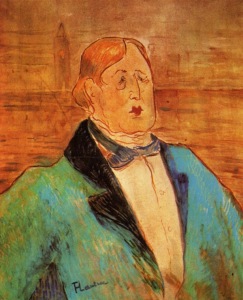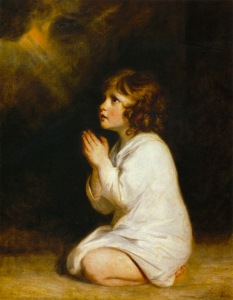London models
by Oscar WildeProfessional models are a purely modern invention. To the Greeks, for instance, they were quite unknown. Mr Mahaffy1, it is true, tells us that Perikles used to present peacocks to the great ladies of Athenian society in order to introduce them to sit to his friend Pheidias, and we know that Polygnotus introduced into his picture of the Trojan women the face of Elpinike, the celebrated sister of the great Conservative leader of the day, but these grandes dames clearly do not come under our category. As for the old masters, they undoubtedly made constant studies from their pupils and apprentices, and even their religious pictures are full of the portraits of their friends and relations, but they do not seem to have had the inestimable advantage of the existence of a class of people whose sole profession is to pose. In fact the model, in our sense of the word, is the direct creation of Academic Schools.
Every country now has its own models, except America. In New York, and even in Boston, a good model is so great a rarity that most of the artists are reduced to painting Niagara and millionaires. In Europe, however, it is different. Here we have plenty of models, and of every nationality. The Italian models are the best. The natural grace of their attitudes, as well as the wonderful picturesqueness of their colouring, makes them facile – often too facile – subjects for the painter’s brush. The French models, though not so beautiful as the Italian, possess a quickness of intellectual sympathy, a capacity in fact, of understanding the artist, which is quite remarkable. They have also a great command over the varieties of facial expression, are peculiarly dramatic, and can chatter the argot of the atelier as cleverly as the critic of the Gil Blas.2 The English models form a class entirely by themselves. They are not so picturesque as the Italian, nor so clever as the French, and they have absolutely no tradition, so to speak, of their order. Now and then some old veteran knocks at the studio door, and proposes to sit as Ajax defying the lightning, or as King Lear upon the blasted heath. One of them some time ago called on a popular painter who, happening at the moment to require his services, engaged him, and told him to begin by kneeling down in the attitude of prayer. “Shall I be Biblical or Shakespearean, sir?” asked the veteran. “Well – Shakespearean,” answered the artist, wondering by what subtle nuance of expression the model would convey the difference. “All right, sir,” said the professor of posing, and he solemnly knelt down and began to wink with his left eye! This class, however, is dying out. As a rule the model, nowadays, is a pretty girl, from about twelve to twenty-five years of age, who knows nothing about art, cares less, and is merely anxious to earn seven or eight shillings a day without much trouble. English models rarely look at a picture, and never venture on any aesthetic theories. In fact, they realise very completely Mr Whistler’s idea of the function of an art-critic, for they pass no criticisms at all. They accept all schools of art with the grand catholicity of the auctioneer, and sit to a fantastic young impressionist as readily as to a learned and laborious academician. They are neither for the Whistlerites nor against them; the quarrel between the school of facts and the school of effects touches them not; idealistic and naturalistic are words that convey no meaning to their ears; they merely desire that the studio shall be warm, and the lunch hot, for all charming artists give their models lunch.
In New York, and even in Boston, a good model is so great a rarity that most of the artists are reduced to painting Niagara and millionaires.”
As to what they are asked to do they are equally indifferent. On Monday they will don the rags of a beggar-girl for Mr Pumper, whose pathetic pictures of modern life draw such tears from the public, and on Tuesday they will pose in a peplum for Mr Phoebus, who thinks that all really artistic subjects are necessarily B.C. They career gaily through all centuries and through all costumes, and, like actors, are interesting only when they are not themselves. They are extremely good-natured, and very accommodating. “What do you sit for?” said a young artist to a model who had sent him in her card (all models, by the way have cards and a small black bag). “Oh, for anything you like, sir,” said the girl; “landscape if necessary!”
Intellectually, it must be acknowledged, they are Philistines, but physically they are perfect – at least some are. Though none of them can talk Greek, many can look Greek, which to a nineteenth-century painter is naturally of great importance. If they are allowed, they chatter a great deal, but they never say anything. Their observations are the only banalités heard in Bohemia. However, though they cannot appreciate the artist as artist, they are quite ready to appreciate the artist as a man. They are very sensitive to kindness, respect and generosity. A beautiful model who had sat for two years to one of our most distinguished English painters, got engaged to a street vendor of penny ices. On her marriage the painter sent her a pretty wedding present, and received in return a nice letter of thanks with the following remarkable postscript: “Never eat the green ices!”
When they are tired a wise artist gives them a rest. Then they sit in a chair and read penny dreadfuls, till they are roused from the tragedy of literature to take their place again in the tragedy of art. A few of them smoke cigarettes. This, however, is regarded by the other models as showing a want of seriousness, and is not generally approved of. They are engaged by the day and by the half-day. The tariff is a shilling an hour, to which great artists usually add an omnibus fare. The two best things about them are their extraordinary prettiness, and their extreme respectability. As a class they are very well behaved, particularly those who sit for the figure, a fact which is curious or natural according to the view one takes of human nature. They usually marry well, and sometimes they marry the artist. In neither case do they ever sit again. For an artist to marry his model is as fatal as for a gourmet to marry his cook, the one gets no sittings, and the other gets no dinners.
On the whole the English female models are very naive, very natural, and very good-humoured. The virtues which the artist values most in them are prettiness and punctuality. Every sensible model consequently keeps a diary of her engagements, and dresses neatly. The bad season is, of course, the summer, when the artists are out of town. However, of late years some artists have engaged their models to follow them, and the wife of one of our most charming painters has often had three or four models under her charge in the country, so that the work of her husband and his friends should not be interrupted. In France the models migrate en masse to the little seaport villages or forest hamlets where the painters congregate. The English models, however, wait patiently in London, as a rule, till the artists come back. Nearly all of them live with their parents, and help to support the house. They have every qualification for being immortalised in art except that of beautiful hands. The hands of the English model are nearly always coarse and red.
For an artist to marry his model is as fatal as for a gourmet to marry his cook, the one gets no sittings, and the other gets no dinners.”
As for the male models, there is the veteran whom we have mentioned above. He has all the traditions of the grand style, and is rapidly disappearing with the school he represents. An old man who talks about Fuseli is, of course, unendurable, and, besides, patriarchs have ceased to be fashionable subjects. Then there is the true Academy model. He is usually a man of thirty, rarely good-looking, but a perfect miracle of muscles. In fact he is the apotheosis of anatomy, and is so conscious of his own splendour that he tells you of his tibia and his thorax, as if no one else had anything of the kind. Then come the Oriental models. The supply of these is limited, but there are always about a dozen in London. They are very much sought after as they can remain immobile for hours, and generally possess lovely costumes. However, they have a very poor opinion of English art, which they regard as something between a vulgar personality and a commonplace photograph. Next we have the Italian youth who has come over specially to be a model, or takes to it when his organ is out of repair. He is often quite charming with his large melancholy eyes, his crisp hair, and his slim brown figure. It is true he eats garlic, but then he can stand like a faun and couch like a leopard, so he is forgiven. He is always full of pretty compliments, and has been known to have kind words of encouragement for even our greatest artists. As for the English lad of the same age, he never sits at all. Apparently he does not regard the career of a model as a serious profession. In any case he is rarely, if ever, to be got hold of. English boys, too, are difficult to find. Sometimes an ex-model who has a son will curl his hair, and wash his face, and bring him the round of the studios, all soap and shininess. The young school don’t like him, but the older school do, and when he appears on the walls of the Royal Academy he is called The Infant Samuel. Occasionally also an artist catches a couple of gamins in the gutter and asks them to come to his studio. The first time they always appear, but after that they don’t keep their appointments. They dislike sitting still, and have a strong and perhaps natural objection to looking pathetic. Besides, they are always under the impression that the artist is laughing at them. It is a sad fact, but there is no doubt that the poor are completely unconscious of their own picturesqueness. Those of them who can be induced to sit do so with the idea that the artist is merely a benevolent philanthropist who has chosen an eccentric method of distributing alms to the undeserving. Perhaps the School Board will teach the London gamin his own artistic value, and then they will be better models than they are now. One remarkable privilege belongs to the Academy model, that of extorting a sovereign from any newly elected Associate or R.A. They wait at Burlington House till the announcement is made, and then race to the hapless artist’s house. The one who arrives first receives the money. They have of late been much troubled at the long distances they have had to run, and they look with disfavour on the election of artists who live at Hampstead or at Bedford Park, for it is considered a point of honour not to employ the underground railway, omnibuses, or any artificial means of locomotion. The race is to the swift.
Besides the professional posers of the studio there are posers of the Row, the posers at afternoon teas, the posers in politics and the circus-posers. All four classes are delightful, but only the last class is ever really decorative. Acrobats and gymnasts can give the young painter infinite suggestions, for they bring into their art an element of swiftness, of motion and of constant change that the studio model necessary lacks. What is interesting in these ‘slaves of the ring’ is that with them Beauty is an unconscious result not a conscious aim, the result in fact of the mathematical calculation of curves and distances, of absolute precision of eye, of the scientific knowledge of the equilibrium of forces, and of perfect physical training. A good acrobat is always graceful, though grace is never his object; he is graceful because he does what he has to do in the best way in which it can be done – graceful because he is natural. If an ancient Greek were to come to life now, which considering the probable severity of his criticisms would be rather trying to our conceit, he would be found far oftener at the circus than at the theatre. A good circus is an oasis of Hellenism in a world that reads too much to be wise, and thinks too much to be beautiful. If it were not for the running-ground at Eton, the towing-path at Oxford, the Thames swimming-baths, and the yearly circuses, humanity would forget the plastic perfection of its own form, and degenerate into a race of short-sighted professors and spectacled précieuses! Not that the circus proprietors are, as a rule, conscious of their high mission. Do they not bore us with the haute école, and weary us with Shakespearean clowns? Still, at least, they give us acrobats, and the acrobat is an artist. The mere fact that he never speaks to the audience shows how well he appreciates the great truth that the aim of art is not to reveal personality but to please. The clown may be blatant, but the acrobat is always beautiful. He is an interesting combination of the spirit of Greek sculpture with the spangles of the modern costumier. He has even had his niche in the novels of our age, and if Manette Salomon be the unmasking of the model, Les Frères Zemganno is the apotheosis of the acrobat.3
It is really of very little use to dress up a London girl in Greek draperies and to paint her as a goddess. The robe may be the robe of Athens, but the face is usually the face of Brompton.”
As regards the influence of the ordinary model on our English school of painting, it cannot be said that it is altogether good. It is, of course, an advantage for the young artist sitting in his studio to be able to isolate ‘a little corner of life,’ as the French say, from disturbing surroundings, and to study it under certain effects of light and shade. But this very isolation leads often to mere mannerism in the painter, and robs him of that broad acceptance of the general facts of life which is the very essence of art. Model-painting, in a word, while it may be the condition of art, is not by any means its aim. It is simply practice, not perfection. Its use trains the eye and the hand of the painter, its abuse produces in his work an effect of mere posing and prettiness. It is the secret of much of the artificiality of modern art, this constant posing of pretty people, and when art becomes artificial it becomes monotonous. Outside the little world of the studio, with its draperies and its bric-à-brac, lies the world of life with its infinite, its Shakespearean variety. We must, however, distinguish between the two kinds of models, those who sit for the figure and those who sit for the costume. The study of the first is always excellent, but the costume-model is becoming rather wearisome in modern pictures. It is really of very little use to dress up a London girl in Greek draperies and to paint her as a goddess. The robe may be the robe of Athens, but the face is usually the face of Brompton. Now and then, it is true, one comes across a model whose face is an exquisite anachronism, and who looks lovely and natural in the dress of any century but her own. This, however, is rather rare. As a rule models are absolutely de nôtre siècle, and should be painted as such. Unfortunately they are not, and, as a consequence, we are shown every year a series of scenes from fancy dress balls which are called historical pictures, but are little more than mediocre representations of modern people masquerading. In France they are wiser. The French painter uses the model simply for study, for the finished picture he goes direct to life.
However, we must not blame the sitters for the shortcomings of the artists. The English models are a well-behaved and hard-working class, and if they are more interested in artists than they are in art, a large section of the public is in the same condition, and most of our modern exhibitions seem to justify its choice.
1 John Pentland Mahaffy (1839–1919): scholar and classicist at Trinity College, Dublin, who had taught Wilde as an undergraduate.
2 Parisian literary journal which published Zola and Maupassant among others.
3 Two novels by Edmond de Goncourt (1822–96).
First published in English Illustrated Magazine, 1889 and reproduced in Beautiful and Impossible Things: Selected Essays of Oscar Wilde.
 Oscar Fingal O’Flahertie Wills Wilde was born in Dublin in 1854 and studied Classics at Dublin and Oxford. His diverse literary output includes the plays The Importance of Being Earnest, An Ideal Husband, Lady Windermere’s Fan and A Woman of No Importance, the novel The Picture of Dorian Gray, stories for children, poetry and a wide-ranging selection of essays and other prose works. Tried for gross indecency in 1895 following the loss of his libel case with the Marquis of Queensberry, he was sentenced to two years’ imprisonment at Wandsworth and Reading jails. His health never recovered. He died in penury in Paris in 1900 and is buried at Père Lachaise cemetery.
Oscar Fingal O’Flahertie Wills Wilde was born in Dublin in 1854 and studied Classics at Dublin and Oxford. His diverse literary output includes the plays The Importance of Being Earnest, An Ideal Husband, Lady Windermere’s Fan and A Woman of No Importance, the novel The Picture of Dorian Gray, stories for children, poetry and a wide-ranging selection of essays and other prose works. Tried for gross indecency in 1895 following the loss of his libel case with the Marquis of Queensberry, he was sentenced to two years’ imprisonment at Wandsworth and Reading jails. His health never recovered. He died in penury in Paris in 1900 and is buried at Père Lachaise cemetery.
Portrait of Oscar Wilde by Napoleon Sarony, 1882 (albumen silver print). Metropolitan Museum of Art/Wikimedia Commons
Beautiful and Impossible Things: Selected Essays of Oscar Wilde, with an introduction by Gyles Brandreth, is published by Notting Hill Editions.
Read more.




